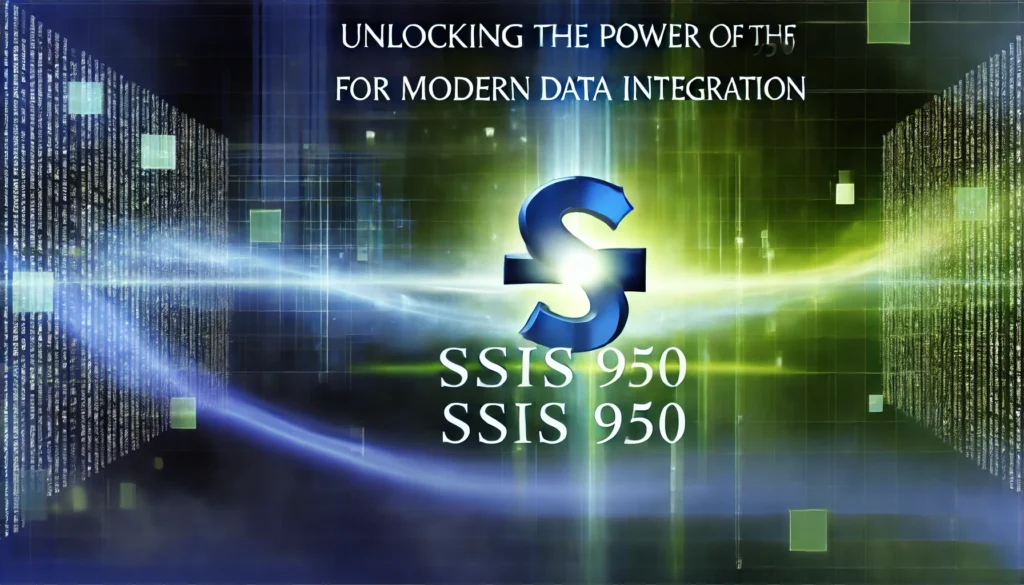Introduction
In today’s data-driven world, the ability to manage, move, and transform data is essential for businesses of all sizes. SSIS 950, an advanced data integration tool within SQL Server Integration Services (SSIS), has emerged as a key solution in the field of Extract, Transform, and Load (ETL) processes. Whether you’re a seasoned data professional or new to the field, understanding the value of SSIS 950 can streamline your data workflows, optimize operations, and enhance data security.
In this article, we’ll dive into what SSIS 950 is, explore its key features, and provide best practices for making the most of this powerful tool. By the end, you’ll have a clearer understanding of how SSIS 950 integrates into the modern data stack, from optimization techniques to industry-specific use cases.
What is SSIS 950?
SSIS 950 refers to a specific project deployment model in SQL Server Integration Services (SSIS), designed to simplify data management through centralized workflows, secure deployment, and dynamic configurations. As a part of Microsoft’s SQL Server, SSIS 950 supports businesses in moving and transforming data efficiently across different environments and systems, saving time and reducing manual work. It’s known for its capabilities to handle complex ETL tasks, offering a unified catalog and robust logging for streamlined data management.
Why SSIS 950 is Essential for Modern Data Integration
The data landscape is more demanding than ever, with companies handling large volumes of information from various sources. SSIS 950 enables organizations to centralize data, automate tasks, and provide improved scalability and security. Here’s why it has become a crucial part of data workflows:
- Centralized Package Management: The SSIS 950 model centralizes all project packages in one database, making management more efficient and reducing the risks associated with decentralized data handling.
- Dynamic Parameterization: With SSIS 950, parameters can be configured dynamically, allowing seamless deployment across development, testing, and production environments without altering the core structure of packages.
- Robust Security Features: Built-in encryption and role-based access control ensure data security, an essential feature for businesses in industries like finance and healthcare.
Key Features of SSIS 950
What sets SSIS 950 apart from previous models are its advanced features designed for data processing efficiency. Here are the standout capabilities of SSIS 950:
- Enhanced Deployment and Management: With SSIS 950, deploying SSIS packages becomes faster and easier, simplifying project management.
- Centralized Storage and Version Control: By storing all packages in the SSISDB catalog, SSIS 950 ensures improved version control and access.
- Improved Logging and Error Tracking: Detailed execution reports and logging provide real-time visibility into the ETL process, making troubleshooting a breeze.
- Support for Parameters: Parameterization adds flexibility, making packages adaptable to different environments and reducing deployment time.
Understanding the Evolution of SSIS: From Legacy Models to SSIS 950
To truly understand SSIS 950, it’s helpful to trace the evolution of SSIS from its earlier models. Each version has brought improvements, but SSIS 950 takes efficiency and security a step further, making it ideal for modern businesses:
- Previous Versions: Earlier models focused mainly on basic ETL functions, with limited automation and minimal cloud integration.
- The Transition to SSIS 950: SSIS 950 has evolved to offer better data flow performance, enhanced debugging, and compatibility with modern databases, positioning it as a go-to solution in today’s data-intensive environments.
How SSIS 950 Fits into the Modern Data Stack
In an era of digital transformation, integrating SSIS 950 with other modern tools is crucial. SSIS 950’s versatility allows it to work seamlessly with various Microsoft solutions, creating a cohesive data ecosystem:
- SQL Server: Native integration with SQL Server databases enables efficient data movement and storage, making it easy to handle large data sets.
- Azure Data Factory: With connectors for cloud storage, SSIS 950 bridges on-premises and cloud environments, facilitating smoother transitions in hybrid setups.
- Power BI: Using SSIS 950, organizations can easily move data to Power BI, streamlining the process of creating insightful visual reports and analytics.
Best Practices for Optimizing SSIS 950 in Large Data Environments
Efficiency is key when dealing with large-scale data processes. Here are some best practices for getting the most out of SSIS 950:
- Leverage Parallelism: Enable data flow parallelism to utilize multiple processors, boosting performance.
- Optimize Data Transformations: Perform complex transformations closer to the data source or destination to reduce processing time within SSIS.
- Use Efficient Logging: Implement selective logging to capture only essential data, reducing overhead and speeding up execution.
- Monitor Regularly: Use SQL Server’s performance monitoring tools to identify and resolve bottlenecks proactively.
Common Use Cases Across Industries for SSIS 950
SSIS 950’s versatility makes it valuable across various industries. Here’s how different sectors use SSIS 950 to manage data:
- Retail: Retail companies use SSIS 950 to integrate POS data, manage inventory, and improve customer insights by merging CRM and sales information.
- Finance: Financial institutions rely on SSIS 950 for automated reporting, transaction data management, and regulatory compliance.
- Healthcare: Hospitals and healthcare organizations benefit from SSIS 950’s secure data handling for processing sensitive patient information and integrating with electronic health records (EHR) systems.
Pros and Cons of Migrating to SSIS 950
While SSIS 950 is packed with advantages, it’s essential to consider both sides before migrating:
Pros:
- Centralized Control: Reduces redundancy and simplifies project management.
- Enhanced Security: Encryption and role-based access provide robust data protection.
- Flexibility with Parameters: Adaptable configuration without altering the package structure.
Cons:
- Learning Curve: For teams used to older SSIS models, there may be a learning curve in understanding the SSISDB catalog and parameterization.
- Deployment Requirements: Requires SQL Server Data Tools (SSDT) and familiarity with the SQL Server environment.
Alternatives to SSIS 950 and When to Consider Them
While SSIS 950 is highly effective within the Microsoft ecosystem, other ETL tools might be more suitable in some cases:
- Apache NiFi: Ideal for organizations working heavily with IoT data, as it provides real-time data flow and stream processing.
- Informatica PowerCenter: Known for its robust data transformation capabilities, it’s suitable for enterprises needing highly customized data integration.
- Talend: An open-source alternative, Talend is favored for its flexibility and affordability, especially for companies with mixed-tech stacks.
Conclusion
SSIS 950 is a powerful, flexible, and secure tool that plays a critical role in modern data integration. From its centralized catalog and robust logging capabilities to the advanced security features, SSIS 950 enables businesses to streamline ETL processes, handle larger data volumes, and secure sensitive information effectively. Whether in retail, healthcare, or finance, SSIS 950 is transforming how organizations manage data.
If you’re considering upgrading from a legacy model, migrating to SSIS 950 can significantly improve your data handling processes. With enhanced scalability, dynamic parameterization, and seamless integration within the Microsoft ecosystem, SSIS 950 stands as a strong foundation for any data-driven organization.
FAQs
- What is SSIS 950?
- SSIS 950 is a project deployment model within SQL Server Integration Services that centralizes package management and offers enhanced security, making it ideal for efficient ETL processes.
- Why is SSIS 950 important for modern data integration?
- With centralized storage, parameterization, and security features, SSIS 950 streamlines data workflows, making it essential for businesses handling complex data environments.
- How does SSIS 950 handle large datasets?
- SSIS 950’s parallel processing and optimized data flow management allow it to process large data volumes efficiently without performance degradation.
- Can SSIS 950 integrate with cloud services?
- Yes, SSIS 950 supports seamless integration with Azure and other cloud services, bridging on-premises and cloud environments effectively.
- What are some best practices for optimizing SSIS 950?
- To optimize SSIS 950, use parallelism, perform data transformations near the source, implement selective logging, and monitor regularly for performance improvements.


